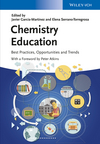Holger Butenschön, Leibniz University, Hanover, Germany, reviews the book Chemistry Education: Best Practices, Opportunities and Trends edited by Javier García-Martínez and Elena Serrano-Torregrosa.
Chemistry Education is a compilation of 28 contributions from international authors spanning 14 countries that clearly shows a worldwide view of the field. After a foreword by Peter Atkins and a preface by the editors, the book is divided into three parts.
A Global Endeavor
Part I, which is entitled Chemistry Education: A Global Endeavour, consists of six chapters and sets a more general scope for the topic. Peter Mahaffy starts the book with a chapter on Chemistry Education and Human Activity; the next chapter by Cathy Middlecamp focuses on Chemistry Education That Makes Connections: Our Responsibilities. Mei-Hung Chiu and Chin-Cheng Chou add the global perspective, and Martin J. Goedhart discusses changing perspectives on the undergraduate curriculum. Empowering Chemistry Teachers’ Learning by Jan H. van Driel and Onno de Jung and the important aspect of lifelong learning in the context of chemistry education complete the first part of the book.
This first part approaches the topic from a rather general view. For example, Mahaffy discusses the difference between “chemical education” and “chemistry education” at the beginning of his contribution. He identifies some “human activities” in the context of chemistry education and gives a number of instructive examples (“exemplars”) for these. In their chapter on the “glocalization” perspective, Chiu and Chou try to bridge the gap between school science practice and daily life of the general population by means of a keyword-based recommendation system based on chemistry-related keywords from textbooks, curricula standards, and newspapers. Beyond the examples mentioned here, all the contributions are presented in a very clear way and are worth reading.
Best Practices and Innovative Strategies
Part II presents Best Practices and Innovative Strategies and is the largest part of the book. It has 16 contributions that vary in length and include topics such as Research on Problem Solving in Chemistry (George M. Bodner), Do Real Work, Not Homework (Brian P. Coppola), Context-Based Teaching and Learning on a School and University Level (Ilka Parchmann et al.), Inquiry-Based Student-Centered Instruction (Ram S. Lamba), and Learners Ideas, Misconceptions, and Challenge (Hans-Dieter Barke). Some of the contributions emphasize the role of experiments in chemistry education: Using Cognitive Conflict Strategy with Classroom Chemistry Demonstrations (Robert (Bob) Bucat) or Experimental Experience Through Project-Based Learning (Jens Josephsen et al.).
This central part of the book is an impressive collection of various possibilities, concepts, and ideas for chemistry education. Topics covered include research-based teaching, problem-solving strategies, work with convergent or divergent tasks, instructional materials such as printed or web-based textbooks, or chemical switches within context-based learning. The reader learns what a “flipped classroom” is and what role it might play in chemistry education; about community-engaged learning projects; and ideas of conceptual integration for learning chemistry. The discussion of the role of language in the teaching and learning of chemistry is interesting even beyond the field of chemistry education, and a paper on chemistry education for gifted learners touches on a field whose importance seems to be somewhat underestimated. A chapter about microscale experiments adds practical aspects to the discussion. Although the contributions of this part vary in length and cover a large number of aspects, the material is interesting to read and represents manifold perspectives on chemistry education.
New Technologies
Part III is devoted to The Role of New Technologies and covers topics such as Twenty-First Century Skills: Using the Web in Chemistry (Jan Apotheker et al.), Chemistry Apps on Smartphones and Tablets (Ling Huang), and E-Learning and Blended Learning in Chemistry Education (Michael K. Seery et al.).
No field of science can survive without using the Internet, and thus the book would be incomplete without covering some developments in chemistry education that make use of modern communication tools. Here the reader finds sections about Massive Open Online Courses (MOOCs), online learning platforms, or the use of augmented reality in (in)formal learning. Visualization is an important topic, particularly for gaining an understanding of the three-dimensionality of most molecules. Drawing tools, periodic system apps, or programs for literature searches are also discussed as modern tools for instruction and learning.
Conclusion
Overall, Chemistry Education familiarizes the reader with a variety of modern developments in the field. Each of the contributions can be read and understood independently. The technical quality of the book is high: Color is used where necessary and useful, but not excessively. The book has an alphabetical index that facilitates searches across the contributions. The book is recommended for anyone active in chemistry education, be it at university or high school, or simply for personal interest. The quality and large amount of interesting information make it good value for money.
 |
Chemistry Education: Best Practices, Opportunities and Trends, |


